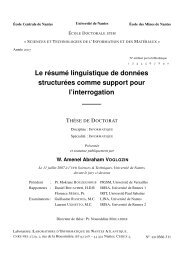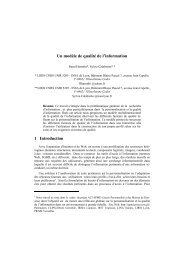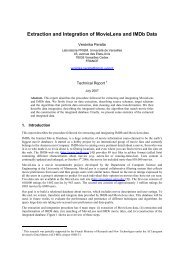Create successful ePaper yourself
Turn your PDF publications into a flip-book with our unique Google optimized e-Paper software.
66 J Intell Inf Syst (2006) 26: 59–73to be considered as results to a query; there is no need for special operators to deal withthe computation-intensive task <strong>of</strong> extending criteria. This section deals with all aspects <strong>of</strong>selection from the expression and meaning <strong>of</strong> a query to its matching with summaries.4.1. Expression <strong>of</strong> a queryThis approach to flexible querying intends to answer questions such as “how are thin materials?”or “how are normal-temperature and s<strong>of</strong>t-hardness materials ?”. In the prototypedeveloped for querying, the questions are expressed using a user-friendly interface that composesthe corresponding query in an SQL-like language. For the two previous questions, thequeries are respectively:Q 1 : SELECT temperature, hardness FROM MATERIALSWHERE thickness IN ("thin")Q 2 : SELECT thickness FROM MATERIALSWHERE temperature IN ("normal") AND hardness IN ("s<strong>of</strong>t")For a more formal expression <strong>of</strong> a query, let:– S be a set <strong>of</strong> attributes;– R(S) be the relation whose tuples are summarized;– Q be a query (e.g., Q 1 and Q 2 in the above example);– A i , i ∈{1,...,n} be an attribute appearing in the query (A i ∈ S);– d i, j , j ∈{1,...,m} be a label (or descriptor) <strong>of</strong> attribute A i , also appearing in the query.In a query, descriptors (like thin, normal or s<strong>of</strong>t in Q 1 and Q 2 ) are called “required characteristics,”and embody the properties that a record must have to be considered as an element<strong>of</strong> the answer.A query also defines the attributes for which required characteristics exist. The set <strong>of</strong> theseinput attributes is denoted by X. The expected answer is a description over a set <strong>of</strong> otherattributes, denoted by Y . Without further precision, Y is the complement <strong>of</strong> X relatively toS: X ∪ Y = S and X ∩ Y =∅.Hence a query defines not only a set X <strong>of</strong> input attributes A i but also, for each attributeA i , the set C Ai <strong>of</strong> its required characteristics. The set <strong>of</strong> sets C Ai is denoted by C, as shownin the following example.Example 1. Let Q 1 and Q 2 be the queries stated above. For each query, the sets are:Q 1 : X ={thickness}, Y ={hardness, temperature},C thick ={thin} and C ={C thick }Q 2 : X ={hardness, temperature}, Y ={thickness},C hard ={s<strong>of</strong>t}, C temp ={normal} and C ={C hard , C temp }.When users formulate a question, they expect that all and only the data with the characteristicsthey specify will be returned. The meaning <strong>of</strong> that question becomes arguable whenmany characteristics are expressed for one attribute or when conditions exist for more thanone attribute.Springer







